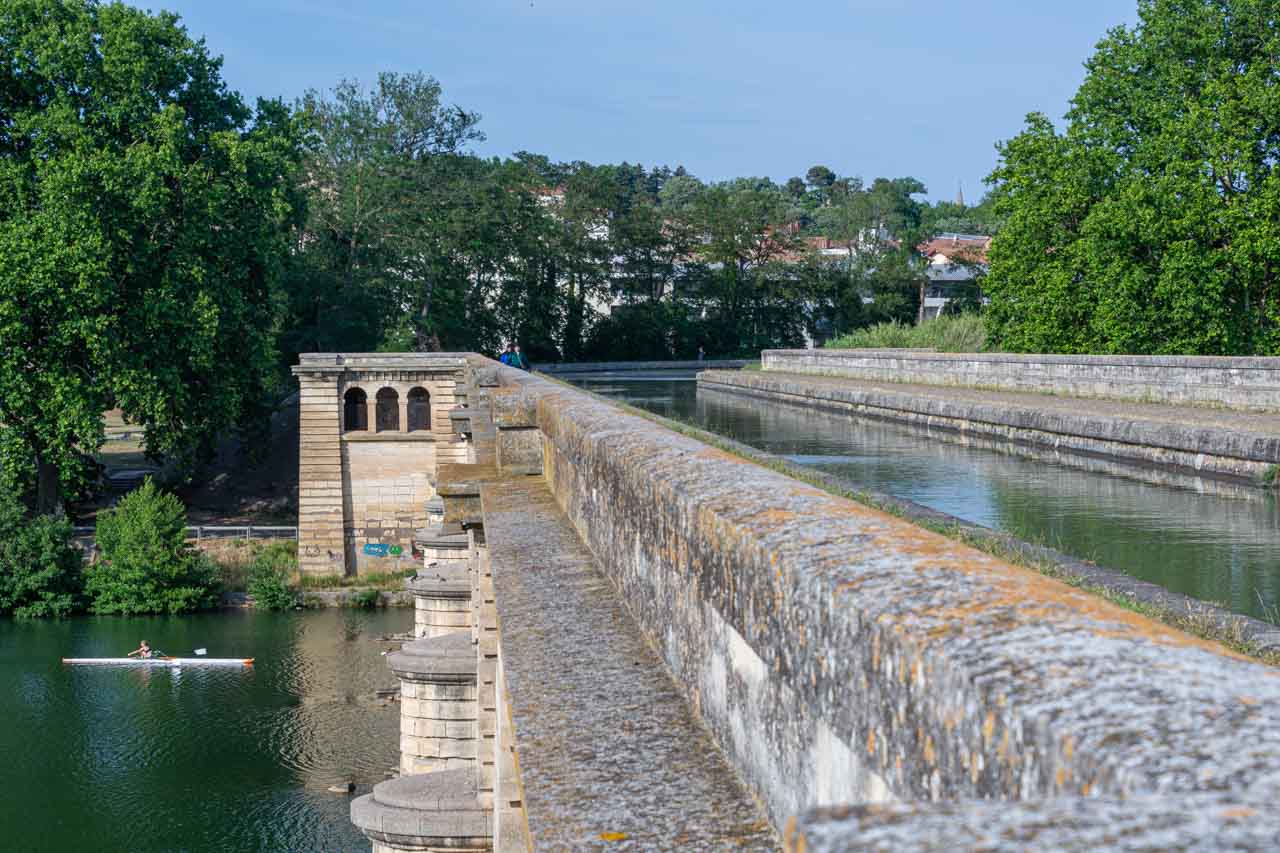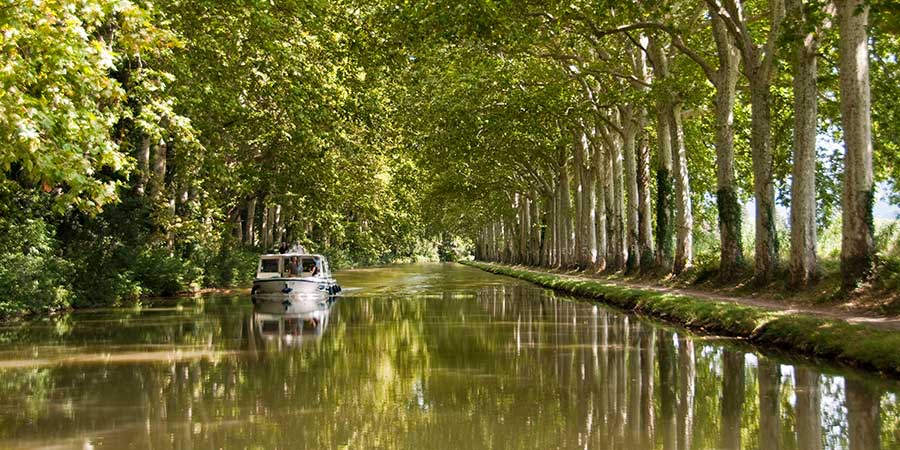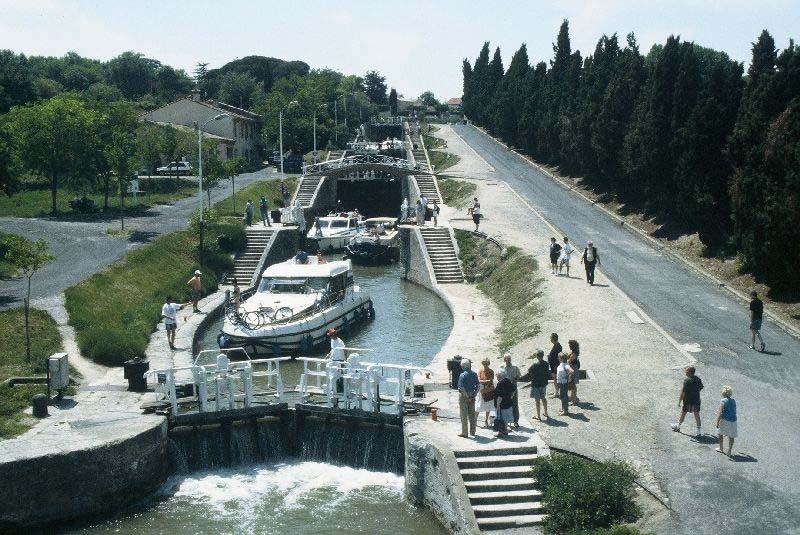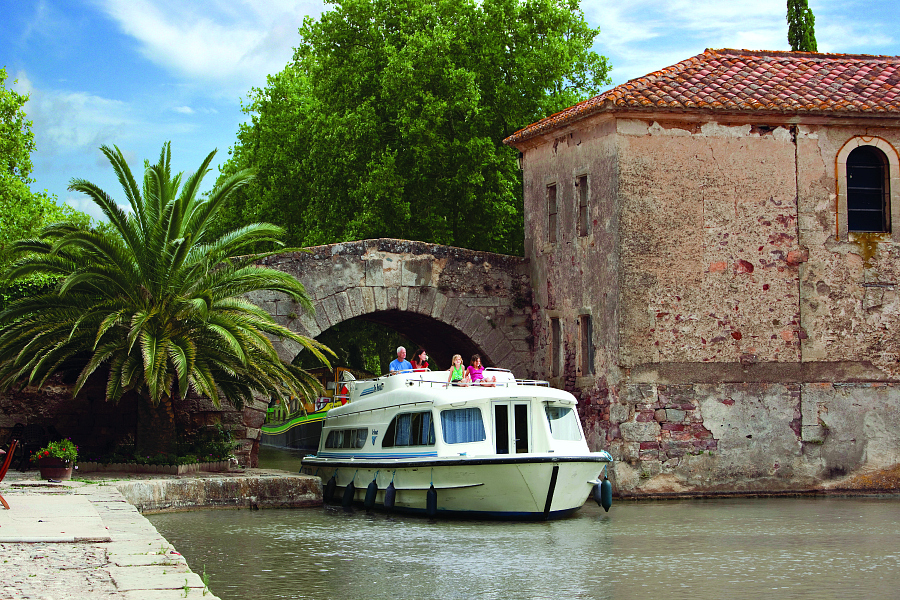I have often been asked what has been our favourite holiday destination, a question impossible to answer because one is not comparing apples with apples but if I were forced to make a choice it would be a canal holiday just like the one we had on the Canal du Midi.
Chaucer’s recent series on his journey in Wanderlust II brings back memories of the most idyllic holiday we ever had. Every holiday has its own attributes but for sheer joy and relaxation our trip along the Canal du Midi stands out as the most idyllic of all.
Life is Simple. Just Add Water.
In April, 2003 my wife and I embarked on a month’s trip to France. It started with a few days of business staying with Frank Bolle whose family company had just been taken over by an American conglomerate and he was embarking on a new venture in eye-ware on his own account.
We flew to Zurich on a Qantas 747. This was my first visit to the EU even though Switzerland was not a member. I was very surprised that there was no customs or immigration process that one normally expects. We just passed through, collected our bags and walked out onto the railway station. There was train waiting to take us to Basel on the French border. When we arrived there was not a single bit of passport process of any kind. Frank was waiting for us and we just walked with him to his car and drove to his beautiful home about 30kms away in France where we spent a long weekend with Frank and his partner.
Frank drove us to Lyon where we caught a train to Castelnaudary, a major stopping point on the Canal du Midi where we were joined by our daughter Julie.
The Canal du Midi was built by a man named Pierre-Paul Riquet under Royal Decree of John-Baptiste Colbert in 1666. It was completed in 1681 and was considered to be one of the outstanding engineering works of the 17th century.
The canal is 240kms in length running from Toulouse where it joins the Canal Garonne giving an uninterrupted waterway from the Atlantic Ocean to the Mediterranean Sea. Its navigable depth is 2 metres with a maximum allowable draft of 1.5 metres. The summit level is 621 feet above sea level and beyond Toulouse it has a rise of 187.6 feet. Chaucer’s Wanderlust II could not sail this canal unless it had a swing keel. Together with the Garonne they form the Canal des Deux Mers (The Canal of The Two Seas)

The object of this canal system was to allow commercial traffic to pass from the Atlantic without having to traverse the bottom of Spain and the Straits of Gibraltar. Today it is not used for commercial traffic but by far the most popular use is tourism for canal cruising on pleasure craft. This of course, was the purpose of our trip in a commodious 25ft cabin cruiser fitted with on double cabin with a saloon that converted to a single berth at night. It also had a galley and bathroom with toilet.
The canal is constructed with a towpath on both sides. Before motor-powered vessels were invented the barges were drawn by horses or men walking along the tow paths and with the exception of those parts that pass through villages the entire length is lined with beautiful plane trees. It is these trees that give the canal its character and serve a multiple of purposes. Their main role was by being planted close together the interlocking roots protected the canal banks from erosion. Then there was the matter of shade for the horses and men pulling the barges and finally, they add untold beauty to the scenery all along the canal.

The villages en route would at one time have had the canal as their main street. It remains as such today but behind the buildings, there are now houses and paved roads. Each village has its wharf with shops, cafes and restaurants opening up onto the canal. One of the joys of our evening meals was to pull up at a waterfront restaurant and savour the beautiful French cuisine and wine. It was always the end of a perfect day.
The canal is a masterpiece of both structural and hydraulic engineering. The ingenuity of Riquet was such that he conceived the need for two basins to contain water so that the locks could always be fed. The construction was undertaken by manual and horse labour which involved the removal of 3,600.000 meters of soil and the construction of a series of oval shaped stone locks 100ft long and 20ft wide at the gates and 36ft in the middle. The oval shape allows two boats to be in a lock at one time with the narrower opening to accommodate the gates. The oval shape also gives added strength against the pressure of the adjacent soil as the locks are being emptied and filled.

The canal is owned by the state and managed by the Dept of Transport. 350 staff are employed to maintain it and it is usually closed for two months while the staff dredge fallen tree branches, leaves and silt. Other remedial works continue throughout the year but major works are done in this period.
When we all arrived at Castelnaudary I was relieved to find that our booking, which had been made through a travel agent in Frankston, Melbourne, fell precisely into place. I was really happy with our boat and after a brief period of instruction we packed our gear on board hired two bicycles and were off. To get the feel of the boat we spent a bit of time running around the large basin. The two bikes were stacked on the cabin roof not tied down. Why would you, the water was a millpond. Around the basin there were lines of very big trees that hung over down to water level.
I drove through one and disaster struck. The bikes got caught in the branches and ended up overboard. We motored around for half an hour trying to snag them with the boat hook but no luck so we had to go back to the hire wharf and admit my guilt. The bikes, I might add were not the latest. Some might say they were dilapidated but functional. I was expecting to have to pay for two more bikes but when I told the boss what I had done he just said “well take two more”, which I did but did not stow them on the roof.
After that I was well and truly experienced and the next test was to traverse a lock, the first of which was right outside the basin. At this lock we were going downhill and it was dead easy. Just tie up the boat alongside and get ready to release the rope when the lock master opens the gates. When the boat settles at the new water level you just let go the rope at the loose end and pull it on board.

This was a gentle introduction to canal cruising which is as simple as falling off a log (or a boat). Before we took off we went to a liquor supermarket of Dan Murphy proportions and stocked up with several bottles of vin. At that time I had never seen a grog supermarket. It was huge and the prices were really good. Bottles and flagons but no casks. They are an insult to French wine so it was said at the time.
That evening we sat in the salon enjoying a few glasses of Vin Rouge. Even in April, the nights in the south of France are quite cold so there was no sitting out on the deck. We were pulled in at a village wharf and at a reasonable hour went to one of the restaurants for our evening meal. Even though there was a galley we had no intention of using it except for breakfast, snacks or making cups of coffee.
Our daughter Julie was, at that time an HR manager with Qantas and had arranged for us to have tour of the Airbus factory at Toulouse where the A380 was being built. Unfortunately, there was some industrial trouble and the plant was locked down for security so our tour did not happen.
We then turned our nose towards the south and leisurely rode the stunningly beautiful canal with its lining of trees and farmlands beyond. We just stopped when we felt like it, tied the boat up to a tree or one of the stakes provided while my wife and daughter took off on the bikes to explore the hinterland. I stayed on the boat to look after it and our belongings. We had been warned not to leave the boat unattended and I was more than happy to be on guard so I could quietly read a book and have a snooze.

These stops along the way were absolutely heaven. The serenity, the scenery other boats passing by, the silence, and the nice warm cabin really were as close to heaven as one can get. During the day as we passed along the canal the activity of passing through locks kept us busy and interested. I was glad to have Julie on board as one needs to be somewhat agile when passing through a lock going up hill. You enter the lock at low water level. The sides of the lock are quite high and steel ladders are embedded in the wall to allow a crew member to climb up, catch a rope and tether the boat to the side. As the lock fills with water the boat rises and when it becomes level with the top the lockkeeper opens the gate and you are on your way again.

At each lock there is a building which houses the lock keeper’s family and storage area for his needs in running the lock. There is no charge for using a lock but the lock keepers are obviously not well to do. At each lock the lock keeper’s wife would come out offering cakes and other goodies for sale. We never passed through a lock without buying something from these ladies. If anything was ever designed to disarm yours
truly it’s a French girl speaking. I just melt. From 9 to 90, French girls have the most beautiful manner of speaking that I have ever heard anywhere and this, together with the obvious need of these wives to make ends meet was enough to shed some joy into their lives.
In some areas where the locks are close together a lock keeper may be in charge of three locks. He attends to one then gets on his bike and rides to the next one. This happens when you are going up or down a hill. It is quite fascinating to be in a boat and looking downhill to where you are going next.
Each night we did our usual routine in some little village until it was time to go to bed in the nice warm cabin. Eventually, we got to a large town called Carcassonne, a fortress town from the Roman days where the canal becomes wide in the middle of this city. We spent a few hours wandering around the town bought some takeaway and headed off back to base to eat it alongside the canal bank.
In both directions we passed a steady flow of other boats and some very big ones where the occupants are permanently housed. These big boats were the type used in commerce but today they are simply for accommodation and in my op inion provide an enviable life style. Many of them are Dutch and because of their size demand a lot of skill in manoeuvring through some locks and around some bends but despite these hazards we did not encounter a single mishap.
After our 10 day delightful sojourn we arrived back at the hire boat base, returned the boat with no defects, and proceeded to our next destination of Nice.
After a couple of days there as a base to visit Cannes and Monte Carlo and Provence, the perfume capital of the world, we moved on to northern France for ANZAC Day and touring the WW1 battlefields.
At Amiens there is a major canal passing through the city. We did not use it but regularly patronised the restaurants fronting it. I gorged myself on French onion soup to the point where a Frenchman at a neighbouring table remarked that you don’t order French onion soup for dessert. Well, I did.
On looking back at our canal voyage one cannot conceive a better way to travel. When the alternative costs of hotels or rented apartments etc is taken into account canal cruising is the ultimate holiday in every way and not expensive.
Add to that the convenience of having a travelling hotel room, freedom to come and go and stop wherever you please, surrounded by the most serene and beautiful environments the only limitation is that canal cruising is only available in a limited number of areas and mostly in Europe.
No great skill is needed in handling the boat. There is never any rough water or weather. Any holiday on water is to be envied but with canal cruising there are none of the pitfalls of open water boating. The only traffic congestion is if you happen to arrive at a lock at the same time as a number of other boats in which case you simply tie up to the bank and wait your turn with a few nobbles of whatever while you wait. Jet skis are not seen on the canals.

The canal system in Europe and Britain is very extensive. Most of it was built for commerce in earlier days when horsepower was generated by four legs and two. In many parts the canals are still used for commerce and in Germany there are canals connecting the Baltic Sea which have been built in modern times.
I have often been asked what has been our favourite holiday destination, a question impossible to answer because one is not comparing apples with apples but if I were forced to make a choice it would be a canal holiday just like the one we had on the Canal du Midi. There are so many options that one could take a holiday on one every year for 10 years with ease. For relaxation, safety and value for money none are equal.
As someone once said,
" Life is simple - just add water "
BLOG COMMENTS POWERED BY DISQUS

















































